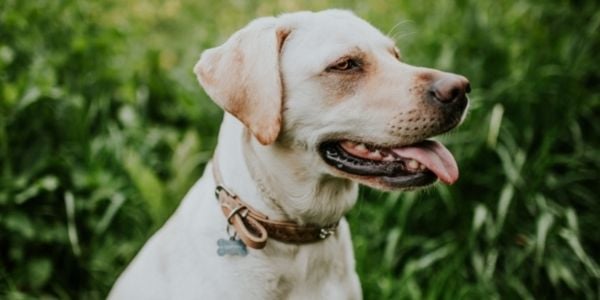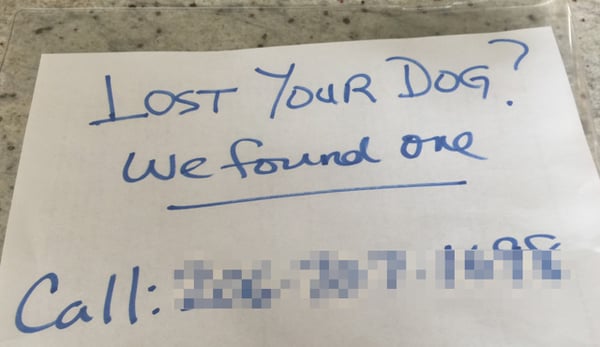 Being able to reunite a lost dog and their owner is a rewarding feeling, but it’s also not always an easy task. Sometimes the dog won't come near you, or for other reasons you can't catch the dog.
Being able to reunite a lost dog and their owner is a rewarding feeling, but it’s also not always an easy task. Sometimes the dog won't come near you, or for other reasons you can't catch the dog.
In this case, taking a photo or writing a description and posting on social media with the location can go a long way in helping someone track down their lost dog.
If you see a loose dog and feel you are prepared and able to help, and if it’s safe to do so, here are some tips to help you find their owner as quickly as possible:
Safely Catch and Contain the Dog
-
Approach the dog calmly and encourage them to come towards you. Always be cautious when approaching an unknown animal, as they might be fearful and could lash out defensively. Turning a bit sideways can help you seem less intimidating to a scared dog, along with slow movement.
The video below is extremely useful in explaining how to use calming signals to settle down a dog in panic.
Read this article for more tips on how your body language can help a dog relax.
- Offering a treat can help entice a dog to come closer to you. DO NOT call out or and chase the dog, as this can scare them and cause them to bolt into an unsafe area, such as into a busy road.
- One trick to try is to open your car door and invite them to "go on a car ride!" with an excited voice. Some dogs will happily jump in the back of your car.
- If the animal is acting aggressively or you cannot safely capture them, contact your local animal control or police department. They will ask you for a description of the dog and the cross streets where you last saw them. Do not put yourself in harm’s way to try and capture a stray dog. To learn how to read dog body language so you can better understand what a dog is trying to tell you, check out our Decoding Dog Body Language Resources.
- Once you have the dog in hand, think about how you will keep them contained and safe while you search for their owner. Attach a leash to the dog, or keep them in a securely fenced area or room in your home. Only keep them in your car if it is well-ventilated, they have access to fresh water, and the weather is not too warm.
- Do not allow the dog to co-mingle with any existing pets you have at home. Not only can this result in fights and possible injury, but you can't be sure that the dog is fully vaccinated or if it has parasites that could be passed on to your pets, such as fleas or ringworm.
- If the dog is injured, you can take it to the closest animal clinic for medical treatment. They will also be able to scan for a microchip and help locate the owner. (However, be prepared to take financial responsibility for any treatment and care.)
- You can make an emergency leash and harness quite easily using anything that you can tie a loop in. It's a great idea to keep a slip lead like this one in your car or bag, in case you do come across a lost animal.
- Watch this video to see how to make an emergency harness and slip lead collar:
Check for Identification and Microchip
- Hopefully the dog will have a collar with identification tags that will make contacting their owner nice and easy. Some dogs wear a microchip tag with their microchip number and contact information for the microchip company, who can then notify the owner that their dog has been found.
- If the dog is wearing a rabies tag, the number listed is unique to the animal and to the veterinary clinic where they received the vaccination. You should be able to call the vet to have them look up the owner information in their system. They will likely contact the owner on your behalf and may offer to take the dog into their clinic in the meantime.
- If you cannot get a hold of the owner right away, it’s helpful to notify animal control, nearby veterinary clinics, and your local animal shelters that you’ve found a dog, in case their owner calls there first.
- If the dog does not have a collar or ID tags, you’ll want to have them scanned to see if they have a microchip. There are a few places that will most likely have a chip scanner:
- A veterinary clinic
- An animal shelter
- A local animal control department
- A retail pet supply store
- If the dog has no ID or microchip, their best bet for being reunited with their owner is through the local animal shelter, as this is usually the first place owners searching for their pets look. If you would rather keep the animal with you, you should give the shelter a photo and description of the dog so they can include them in their found postings, and provide them with your contact information.
Spread the Word and Post "Found Dog" Fliers
- If possible, take a photo of the dog and create a flyer to post in the area you found the pet. You can also distribute these fliers to local veterinary clinics as well, or go door-to-door in the neighborhood where you found them.
We've created a Found Pet Flyer template you can download for free here: - There are many groups on social media specifically for posting about lost and found animals. If you're on Facebook, post a photo in your feed. Many pets have been reunited with their owners this way. Browse any lost pet listings and post about having found a dog. A few larger databases include Pawboost, Home Again, PetFBI, and The Center for Lost Pets. Another great site that connects you with neighbors is Nextdoor.
Beware: Unfortunately there have been instances when people posing as the owner of a lost dog contact the finder and claim the dog belongs to them, especially with purebred dogs or puppies.
When posting on sites such as the craigslist.org pet bulletin board, consider posting a brief listing without a photo (or a cropped photo) that asks the owner to contact you and give you more specific physical information about their dog to prove their ownership. Don't ever disclose the dog's name (if it's visible on their tag), as asking this question of the inquirer is a first step in identifying if they truly own the pet, as in most cases if you use that name with the dog, they'll get excited.
This beauty ran by our office window a while ago and we lured her in and found her owner. She didn't have tags, but knowing her name (provided by the caller) helped us know the caller was legit.
- If you're keeping the dog with you until you find the rightful owner and you live in a house, it can be useful to put up a sign in front of your place that says you've found an animal (example in photo below). Often pet owners drive the neighborhood where they live desperately trying to find their pet, so your note will catch their eye.




